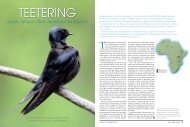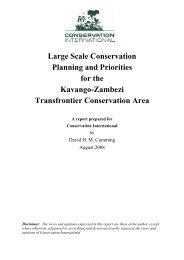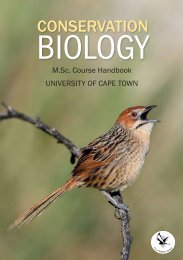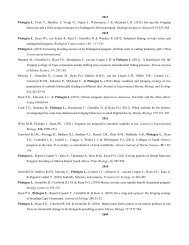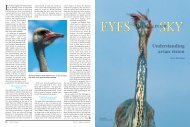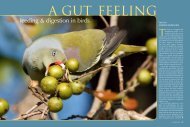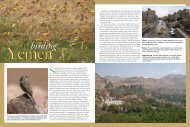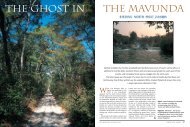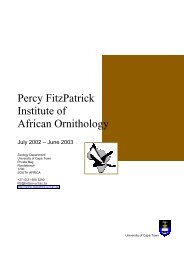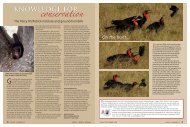Preening power: red-billed woodhoopoes go on the defensive
Preening power: red-billed woodhoopoes go on the defensive
Preening power: red-billed woodhoopoes go on the defensive
- No tags were found...
You also want an ePaper? Increase the reach of your titles
YUMPU automatically turns print PDFs into web optimized ePapers that Google loves.
Red-<str<strong>on</strong>g>billed</str<strong>on</strong>g> Woodhoopoes <str<strong>on</strong>g>go</str<strong>on</strong>g> <strong>on</strong> <strong>the</strong> <strong>defensive</strong>PREENINGPOWERText by Ross WanlessIn <strong>the</strong> wild, every day is a struggle betweenlife and death. P<str<strong>on</strong>g>red</str<strong>on</strong>g>ators lurk in <strong>the</strong> shadows,hunting by night, using <strong>the</strong> minutest sounds and fainttrails of scents that waft through <strong>the</strong> branches, undetectedby human noses, to locate <strong>the</strong>ir prey.In <strong>the</strong> woodlands and forests of Africa, <strong>on</strong>e species has hit up<strong>on</strong> animpressive way of defending itself from <strong>the</strong> denizens of <strong>the</strong> dark. Chris van Rooyen
The Red-<str<strong>on</strong>g>billed</str<strong>on</strong>g> Woodhoopoe Phoeniculuspurpureus is an intriguing species.Because it lives in groups, itssociety is a rich tapestry of inter acti<strong>on</strong>s,alliances, betrayals and secrets. Its life isplayed out in <strong>the</strong> forests and woodlandsof sub-Saharan Africa, where it is <strong>on</strong>e of<strong>the</strong> more c<strong>on</strong>spicuous birds. Its noisycalls echo and resound across valleys,while territorial disputes between neighboursachieve impressive crescendos. Onewould struggle not to see <strong>the</strong>se birdswhen walking through any reas<strong>on</strong>ablylarge tract of forest or well-wooded habitat.The species’ raucous cackling givesrise to its Xhosa name, Hlekabafazi, whichmeans ‘laughing women’.For almost 30 years biologists havebeen studying <strong>the</strong>se somewhat bizarre,but ingratiatingly endearing birds. Theirintricate lives are unique am<strong>on</strong>g birdsin a number of ways and, despite animpressive volume of research, <strong>the</strong>yc<strong>on</strong>tinue to surprise.An unusual strategyOne of <strong>the</strong> Red-<str<strong>on</strong>g>billed</str<strong>on</strong>g> Woodhoopoe’smore unusual traits is its need to roostin cavities (usually in trees), a situati<strong>on</strong>complicated by <strong>the</strong> fact that <strong>the</strong> birdscannot excavate <strong>the</strong>ir own holes. Thisreliance <strong>on</strong> o<strong>the</strong>r animals’ (or nature’s)handiwork places <strong>the</strong>m under tremendouspressure. In many areas, <strong>the</strong>reis enormous competiti<strong>on</strong> between severalcavity-roosting species, and <str<strong>on</strong>g>woodhoopoes</str<strong>on</strong>g>are always <strong>on</strong> <strong>the</strong> lookout for aback-up cavity in <strong>the</strong>ir territory.Woodhoopoes breed communally. Inmost recorded cases of breeding attempts,<strong>the</strong> alpha pair breed, and any o<strong>the</strong>r membersof <strong>the</strong> group help in <strong>the</strong> rearing of<strong>the</strong> brood. The business of helping o<strong>the</strong>rsto raise young ra<strong>the</strong>r than breeding <strong>on</strong>eselfis quite intriguing. At first glance itmight not make much sense to expend alot of time and energy helping to rearano<strong>the</strong>r pair’s young. Why d<strong>on</strong>’t <strong>the</strong>sehelpers <str<strong>on</strong>g>go</str<strong>on</strong>g> off and breed <strong>the</strong>mselves?Firstly, some year-old birds do manageto establish territories and breed. Theirsuccess rate is, however, generally ra<strong>the</strong>rlow. By c<strong>on</strong>trast, helpers seem able tolearn what to do, and when <strong>the</strong>y establish<strong>the</strong>mselves as breeders, <strong>the</strong>y tend todo much better than o<strong>the</strong>rs. It takes a lotof practice and skill to forage in <strong>the</strong>woodlands for <strong>on</strong>eself, let al<strong>on</strong>e for aChris van rooyenLeft and right Communalliving has advantages for <strong>the</strong><str<strong>on</strong>g>woodhoopoes</str<strong>on</strong>g> – increased numbersmean a better defence systemand more helpers to feed<strong>the</strong> young.brood of highly demanding, growingchicks. A sec<strong>on</strong>d reas<strong>on</strong> is that moreoften than not, helpers are ‘family’; ei<strong>the</strong>roffspring from earlier breeding attemptsor related (typically siblings) to <strong>on</strong>e of <strong>the</strong>alpha pair. It makes biological sense toinvest in <strong>on</strong>e’s family, even if <strong>the</strong> youngbeing ca<str<strong>on</strong>g>red</str<strong>on</strong>g> for aren’t <strong>on</strong>e’s own. Becauseof this ‘blood c<strong>on</strong>necti<strong>on</strong>’ or relatedness,helpers invest <strong>the</strong>ir efforts in ensuringthat <strong>the</strong>ir sha<str<strong>on</strong>g>red</str<strong>on</strong>g> genes are passed <strong>on</strong> to<strong>the</strong> next generati<strong>on</strong>. This co-operativebreeding strategy is employed by a diversityof animals, ranging from h<strong>on</strong>ey-beesand ants to naked mole-rats.A third reas<strong>on</strong> is that in some circumstancesroosting cavities and territoriesare hard to come by, and even harder todefend. A larger group can usually defenda cavity or maintain a large territory, andwhen times are tough, for example intimes of drought, territories are oftenexpanded to improve foraging. Under<strong>the</strong>se circumstances, small groups run<strong>the</strong> risk of being displaced completely.This can be an utter disaster for <str<strong>on</strong>g>woodhoopoes</str<strong>on</strong>g>,which have to find safe roostingcavities every night. It seems that<strong>the</strong> best opti<strong>on</strong>, unless ano<strong>the</strong>r territorycan be found immediately, is to joinano<strong>the</strong>r group.The disadvantage of joining ano<strong>the</strong>rgroup is that newcomers always start at<strong>the</strong> bottom of <strong>the</strong> ladder. A very str<strong>on</strong>gpecking order is present in most grouplivingbirds and in <str<strong>on</strong>g>woodhoopoes</str<strong>on</strong>g> thistakes <strong>on</strong> added significance. Should <strong>on</strong>eof <strong>the</strong> alpha pair die, <strong>the</strong> male or femalenext in line in <strong>the</strong> pecking order willtake over as breeders. For newcomersthis can mean a very l<strong>on</strong>g wait for <strong>the</strong>chance to reproduce.Threats from p<str<strong>on</strong>g>red</str<strong>on</strong>g>atorsNo <strong>on</strong>e is really too sure why <str<strong>on</strong>g>woodhoopoes</str<strong>on</strong>g>always roost in a cavity. Some evidencesuggests that during winter, grouphuddling in cavities can result in a c<strong>on</strong>siderablesaving of energy. This does notexplain why, <strong>on</strong> warm nights, cavi- Brendan Ryan56 <str<strong>on</strong>g>red</str<strong>on</strong>g>-<str<strong>on</strong>g>billed</str<strong>on</strong>g> WoodHoopoesfebruary/march 2001<str<strong>on</strong>g>red</str<strong>on</strong>g>-<str<strong>on</strong>g>billed</str<strong>on</strong>g> WoodHoopoes57
ties are prefer<str<strong>on</strong>g>red</str<strong>on</strong>g> over safe roosts inthorn bushes or high up in trees. Whatis known for sure, how ever, is thatroosting in cavities can be downrightdangerous. Cavity raiding by nocturnal,arboreal p<str<strong>on</strong>g>red</str<strong>on</strong>g>ators such as genets, treecivets, African wild cats and feral domesticcats, and possibly a number of snakespecies, is well known and in some areasis a significant cause of death. Wherever<strong>the</strong>re are str<strong>on</strong>g forces (for example,high levels of p<str<strong>on</strong>g>red</str<strong>on</strong>g>ati<strong>on</strong>) acting <strong>on</strong>populati<strong>on</strong>s, <strong>the</strong>re are equally str<strong>on</strong>gforces of natural selecti<strong>on</strong> that act toalleviate those pressures. Group-livingand cavity roosting seem to have set <strong>the</strong>stage for a str<strong>on</strong>g selective pressure for<str<strong>on</strong>g>woodhoopoes</str<strong>on</strong>g> to evolve some mechanismthat would counteract <strong>the</strong> highrisk of p<str<strong>on</strong>g>red</str<strong>on</strong>g>ati<strong>on</strong>.DefenceMany organisms use chemicals in a varietyof ways to defend <strong>the</strong>mselves againstp<str<strong>on</strong>g>red</str<strong>on</strong>g>ators. They do it by being malodorous,tasting really bad, or actually beingpois<strong>on</strong>ous. Skunks do it. Butterflies doit. Frogs do it. Fish doit. But birds? Surprisingly, chemicaldefence has been documented in morethan 120 species of birds. Two wellknownsou<strong>the</strong>rn African gamebird species,<strong>the</strong> Comm<strong>on</strong> Quail Coturnixcoturnix, and <strong>the</strong> Spur-winged GoosePlectropterus gambensis are so pois<strong>on</strong>ousthat <strong>the</strong>y can kill. Luckily <strong>the</strong>y are nottoxic during <strong>the</strong> time <strong>the</strong>y spend insou<strong>the</strong>rn Africa. The quail eats nastyEuropean plants like hemlock shortlybefore its seas<strong>on</strong>al migrati<strong>on</strong> in Europe,and if eaten at this stage <strong>the</strong> birdcan cause an illness known in medicalparlance as ‘coturnism’. (Despite this,hunting and eating quail remains anati<strong>on</strong>al pastime in much of sou<strong>the</strong>rnEurope.) Ano<strong>the</strong>r migrant, <strong>the</strong> SpurwingedGoose spends much of its timein The Gambia, where it eats a particularlypois<strong>on</strong>ous beetle not found insou<strong>the</strong>rn Africa. Both <strong>the</strong>se species, andindeed all o<strong>the</strong>r known examples ofchemically defended birds, take <strong>the</strong> toxins<strong>the</strong>y use from <strong>the</strong>ir diet.The exact nature of chemical defenceis known in relatively few bird species,with <strong>the</strong> most recent evidence comingfrom <strong>the</strong> genus Pitohui. Three species ofPitohui, endemic to New Guinea, havebeen shown to have a toxic compoundof a class found <strong>on</strong>ly in <strong>on</strong>e o<strong>the</strong>r tax<strong>on</strong>omicallyand geographically distantgroup, <strong>the</strong> neotropical pois<strong>on</strong>-dart frogsof <strong>the</strong> genus Phyllobates. The chemicalcompounds found in <strong>the</strong> skin and musclesof Pitohui species are believed to bestr<strong>on</strong>g enough to kill a medium-sizedbird of prey.The way of <strong>the</strong> <str<strong>on</strong>g>woodhoopoes</str<strong>on</strong>g>All birds have a small preen gland situatedabove <strong>the</strong> tail, at <strong>the</strong> base of <strong>the</strong>spine. In most birds <strong>the</strong> gland secretes avariety of fatty acids, oils and o<strong>the</strong>rorganic com pounds, which <strong>the</strong> birdsspread <strong>on</strong> <strong>the</strong>ir fea<strong>the</strong>rs during preening.Such preening has two widely recognisedfuncti<strong>on</strong>s: in much <strong>the</strong> same way asregu larly used wood or lea<strong>the</strong>r needs oiling,<strong>the</strong> oils of <strong>the</strong> gland are c<strong>on</strong>side<str<strong>on</strong>g>red</str<strong>on</strong>g>essential to <strong>the</strong> maintenance of <str<strong>on</strong>g>go</str<strong>on</strong>g>odfea<strong>the</strong>r c<strong>on</strong>diti<strong>on</strong>; <strong>the</strong> sec<strong>on</strong>d functi<strong>on</strong>may be for fungicidal, bactericidal oro<strong>the</strong>r hygienic purposes.Woodhoopoes seem to have found athird and unique use for this gland. Theirpreen gland is capable of producing ascent so str<strong>on</strong>g that experiencedre searchers can tell how recently a roostcavity was used, based <strong>on</strong>ly <strong>on</strong> <strong>the</strong> lingerin<str<strong>on</strong>g>go</str<strong>on</strong>g>dour. Fur<strong>the</strong>r, <strong>the</strong> secreti<strong>on</strong> remainsdetectable for several hours <strong>on</strong> <strong>the</strong> handsof those who have handled birds (and isextremely unpleasant to taste). In short,<str<strong>on</strong>g>woodhoopoes</str<strong>on</strong>g> smell bad!Yet more compelling, albeit circumstantial,evidence for chemical defencecomes from woodhoopoe behaviour.When disturbed at <strong>the</strong>ir roost cavities,<str<strong>on</strong>g>woodhoopoes</str<strong>on</strong>g> do something ra<strong>the</strong>runusual. Normally, birds will try todefend <strong>the</strong>mselves with <strong>the</strong>ir bills, and<str<strong>on</strong>g>woodhoopoes</str<strong>on</strong>g> certainly have bills l<strong>on</strong>genough for us to suppose <strong>the</strong>y might do<strong>the</strong> same. Curiously, <strong>the</strong>y face away froma threat. Not <strong>on</strong>ly do <strong>the</strong>y turn tail, but<strong>the</strong>y also expose <strong>the</strong>ir preen gland.Typically, <strong>the</strong> emissi<strong>on</strong> of a drop of <strong>the</strong>irextremely pungent se creti<strong>on</strong> accompaniesthis behaviour. This resp<strong>on</strong>se tothreat seems to be designed to maximise<strong>the</strong> effect of a deterrent odour. Viewed inthis light, <strong>the</strong>ir strange reacti<strong>on</strong> to p<str<strong>on</strong>g>red</str<strong>on</strong>g>ators(and biologists) looks remarkablyastute instead of mystifyingly silly.This has led researchers to speculatethat <strong>the</strong> unpleasant secreti<strong>on</strong> is used inchemical defence. Speculati<strong>on</strong>, c<strong>on</strong>jectureand circumstantial evidence are allvery well, but how does <strong>on</strong>e prove thata bird uses chemicals to defend itselfagainst p<str<strong>on</strong>g>red</str<strong>on</strong>g>ators?The proof of <strong>the</strong> pudding...The first step was to identify what compoundswere resp<strong>on</strong>sible for <strong>the</strong> smell.Professor Ben Burger of <strong>the</strong> University ofStellenbosch, toge<strong>the</strong>r with a student,analysed <strong>the</strong> chemical compositi<strong>on</strong> ofwoodhoopoe preen-gland secreti<strong>on</strong>s.They identified a suite of volatile compoundsresp<strong>on</strong>sible for <strong>the</strong> <str<strong>on</strong>g>power</str<strong>on</strong>g>ful scentassociated with <str<strong>on</strong>g>woodhoopoes</str<strong>on</strong>g>. In fact<strong>the</strong>re were so many compounds that <strong>the</strong>odours could quite likely be used foro<strong>the</strong>r purposes, such as territorial orroost-cavity defence, communicati<strong>on</strong> or<strong>the</strong> maintenance of social structure, andkeeping ectoparasites such as fea<strong>the</strong>rmites and lice at bay.Once <strong>the</strong> smell-producing compoundshad been identified, <strong>the</strong>y could be syn<strong>the</strong>sisedin relatively large quantities.This meant I could set about testingwhe<strong>the</strong>r <strong>the</strong> woodhoopoe secreti<strong>on</strong> wasin fact a deterrent to p<str<strong>on</strong>g>red</str<strong>on</strong>g>ators. Simplefood-choice tests were performed <strong>on</strong>domestic cats, using canned cat foodlaced with <strong>the</strong> syn<strong>the</strong>tic scent. Theassumpti<strong>on</strong>s behind this were that catsare representative of <strong>the</strong> kind of p<str<strong>on</strong>g>red</str<strong>on</strong>g>atorslikely to investigate tree cavities. Ihad to make sure <strong>the</strong> cats were hungry, sothat if <strong>the</strong>y left any food uneaten it wasbecause <strong>the</strong>y really didn’t like it. I gave<strong>the</strong> hungry cats a choice of two bowls ofcanned cat food, <strong>on</strong>e normal and <strong>the</strong>o<strong>the</strong>r laced with <strong>the</strong> chemicals found inwoodhoopoe preen glands.... is in <strong>the</strong> smellThe results of <strong>the</strong> tests were totallyunequivocal, but not what I hadexpected. P<str<strong>on</strong>g>red</str<strong>on</strong>g>ictably, all <strong>the</strong> cats <str<strong>on</strong>g>go</str<strong>on</strong>g>bbled<strong>the</strong> unscented food. Some took<strong>on</strong>e sniff at <strong>the</strong> bowl of smelly food,turned up <strong>the</strong>ir noses and went to lick<strong>the</strong> untainted bowl clean. Most, however,attempted to eat <strong>the</strong> food despiteits smell. All gave up after realising<strong>the</strong> food not <strong>on</strong>ly smelled bad, buttasted disgusting too. What this simpleexperiment showed is that <str<strong>on</strong>g>woodhoopoes</str<strong>on</strong>g>cent is a <str<strong>on</strong>g>power</str<strong>on</strong>g>ful deterrent top<str<strong>on</strong>g>red</str<strong>on</strong>g>ators. However, because most of<strong>the</strong> cats at least attempted to eat <strong>the</strong>food, even though it smelled very bad,I could not c<strong>on</strong>clude that bad smellal<strong>on</strong>e is enough to deter hungry p<str<strong>on</strong>g>red</str<strong>on</strong>g>ators.Woodhoopoes, just like incometaxreturns, are ra<strong>the</strong>r complicated.Some of <strong>the</strong> cats were prepa<str<strong>on</strong>g>red</str<strong>on</strong>g> to tryand eat <strong>the</strong> food, even though it clearlysmelled bad and tasted even worse. Thissuggests that under natural c<strong>on</strong>diti<strong>on</strong>sat least some p<str<strong>on</strong>g>red</str<strong>on</strong>g>ators are likely toattempt to capture roosting <str<strong>on</strong>g>woodhoopoes</str<strong>on</strong>g>.What probably happens in natureis that <strong>the</strong> p<str<strong>on</strong>g>red</str<strong>on</strong>g>ator would kill and possiblyeat a woodhoopoe. But it woulddo so without relish, and would learn toavoid in future any cavities that had <strong>the</strong>tell-tale smell of <str<strong>on</strong>g>woodhoopoes</str<strong>on</strong>g> whichwould serve as a warning that <strong>the</strong>sebirds are not a tasty meal.Woodhoopoes are <strong>the</strong> first birds tohave proven chemical defence againstp<str<strong>on</strong>g>red</str<strong>on</strong>g>ators. Fur<strong>the</strong>r research may revealmore surprises. To date, all o<strong>the</strong>r chemicalsused by birds in <strong>the</strong>ir defence arethought to have been sequeste<str<strong>on</strong>g>red</str<strong>on</strong>g> fromplants or insects in <strong>the</strong> diet. The preengland naturally produces a wide rangeof organic chemicals and <strong>the</strong>re is everyreas<strong>on</strong> to believe that <str<strong>on</strong>g>woodhoopoes</str<strong>on</strong>g>are <strong>the</strong> first birds known to sciencethat syn<strong>the</strong>sise <strong>the</strong>ir own <strong>defensive</strong>compounds.<str<strong>on</strong>g>Preening</str<strong>on</strong>g> not <strong>on</strong>ly enhances fea<strong>the</strong>rc<strong>on</strong>diti<strong>on</strong> in <strong>the</strong> Red-<str<strong>on</strong>g>billed</str<strong>on</strong>g> Woodhoopoe,but it may well be part of <strong>the</strong> species’defence armoury by making it smell andtaste foul to p<str<strong>on</strong>g>red</str<strong>on</strong>g>ators.chris van Rooyen58 <str<strong>on</strong>g>red</str<strong>on</strong>g>-<str<strong>on</strong>g>billed</str<strong>on</strong>g> WoodHoopoesafrica – birds & birding<str<strong>on</strong>g>red</str<strong>on</strong>g>-<str<strong>on</strong>g>billed</str<strong>on</strong>g> WoodHoopoes59



